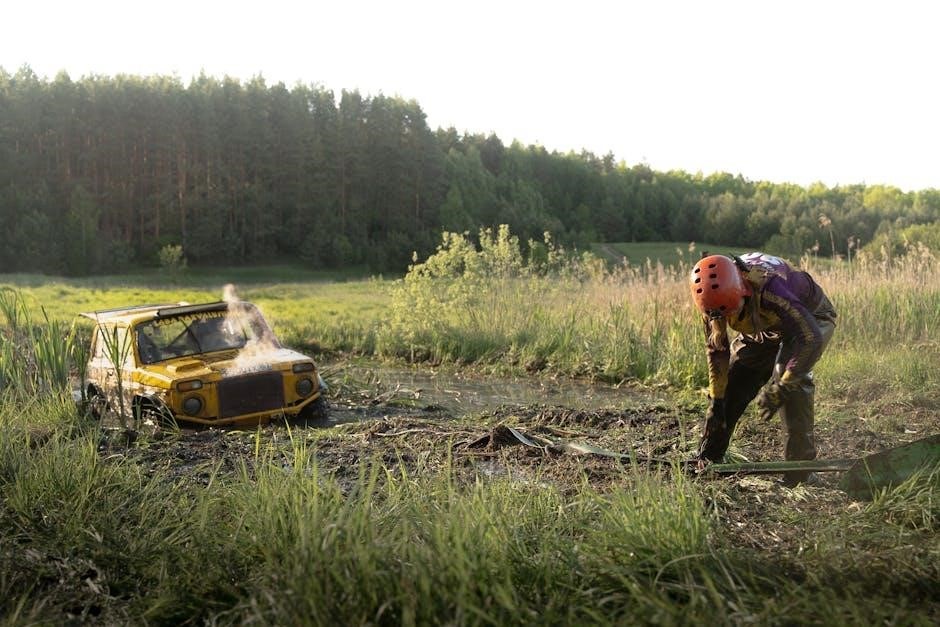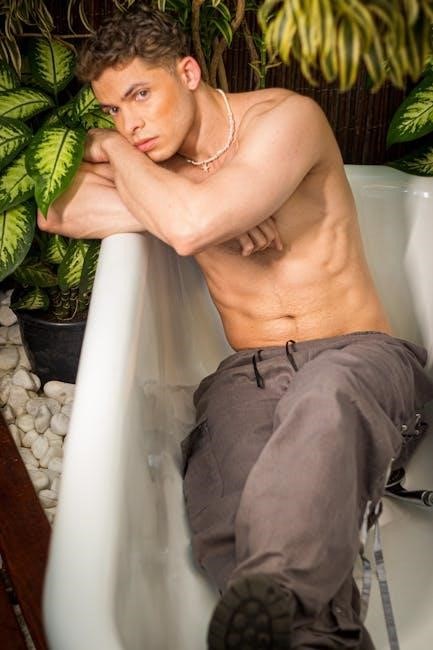1.1 Overview of Common Hot Tub Issues
Hot tubs often face issues like malfunctioning heaters, faulty pumps, or leakages. Regular maintenance and timely troubleshooting can prevent major repairs, ensuring a relaxing and safe experience.
Common hot tub issues include malfunctioning heaters, noisy pumps, leaks, and error codes. Regular maintenance can prevent these problems, but when they arise, understanding the root cause is key to effective troubleshooting. Addressing these issues promptly ensures a safe, relaxing, and enjoyable hot tub experience.
1.2 Importance of Regular Maintenance
Regular maintenance is crucial for extending the lifespan of your hot tub and preventing common issues. Cleaning filters, checking chemical levels, and inspecting components ensure optimal performance. Proper upkeep also enhances safety, energy efficiency, and the overall enjoyment of your hot tub experience while reducing the need for costly repairs.

Essential Tools and Materials for Troubleshooting
Essential tools include a multimeter, wrench, and screwdrivers for diagnostics. Cleaning supplies like filters and chemicals are vital. Keep replacement parts on hand to address common issues efficiently.
2.1 Must-Have Tools for DIY Repairs
Multimeters, screwdrivers, and wrenches are essential for diagnosing electrical and mechanical issues. Pliers and Allen keys help with tight spaces. A pressure test kit and leaking detection tools assist in identifying water loss sources, ensuring quick and effective DIY repairs for your hot tub.
2.2 Chemicals and Cleaning Supplies
Essential chemicals include pH balancers, chlorine or bromine sanitizers, and shock treatments to maintain clean water. Cleaning supplies like filter cleaners, tile cleaners, and vinyl protectants help keep the hot tub hygienic and extend equipment lifespan, ensuring optimal performance and safety for users.
Basic Troubleshooting Steps
Start by identifying the issue, checking power supply, and reviewing error codes. Inspect the control panel, reset the system if needed, and ensure proper connections for smooth operation.
3.1 Checking the Control Panel
Examine the control panel for error messages or unusual displays. Ensure it’s properly powered and unlocked. Verify temperature settings and check if all buttons function correctly. Consult the manual for specific codes or instructions to address any issues promptly and effectively.
3.2 Understanding Error Codes
Error codes on your hot tub’s control panel indicate specific issues, such as faulty heaters or low flow. Refer to the user manual to decode these messages. Understanding error codes helps pinpoint problems quickly, allowing you to address them effectively and prevent further damage or downtime.
3.3 Resetting the System
Resetting your hot tub system can resolve many issues. Turn off the power, wait a few minutes, then restore it. This often clears error codes or malfunctions. If problems persist, consult your user manual or contact a professional for assistance. Regular resets can help maintain optimal performance and prevent future complications.
Hot Tub Not Turning On
If your hot tub won’t turn on, check the power supply, ensure the circuit breaker isn’t tripped, and inspect the control panel for error messages or damage.
4.1 Checking Power Supply
Ensure the power supply is on and check the circuit breaker or GFCI for tripped switches. Verify the outlet’s voltage matches the hot tub’s requirements. If unsure, use a multimeter to test the power. Always prioritize electrical safety and avoid DIY repairs if uncertain. Ensure all connections are secure and the control panel is unlocked.
4.2 Inspecting the Control Panel
Check the control panel for error messages or blinking lights. Ensure all buttons function properly and settings are correct. Verify that the panel is clean and free of moisture. If locked, unlock it using the manufacturer’s instructions. Resetting the panel may resolve issues, but consult the manual first to avoid further problems.
4.3 Testing Circuit Breakers
Locate the circuit breaker box and check if the hot tub’s breaker has tripped. Switch it off, wait a few seconds, and reset it. Ensure all connections are secure and not loose. If the issue persists, consult a licensed electrician to inspect the electrical system for any underlying faults or damage.
4.4 Wiring and Connections
Inspect all wiring and connections for signs of wear, corrosion, or damage. Ensure they are securely fastened and not loose. Check for any frayed cords or broken insulation. If damaged, replace immediately to prevent electrical hazards. Refer to your hot tub manual for specific wiring diagrams and connection guidelines.

Hot Tub Not Heating
If your hot tub isn’t heating, start by checking the temperature settings and ensuring the thermostat is functioning properly. Inspect the heater element for damage and clean or replace the filter if it’s clogged. Verify that all electrical connections are secure and check for blown fuses or tripped breakers. If issues persist, consult a professional to diagnose and repair any internal components.
5.1 Checking Temperature Settings
Ensure the desired temperature is set correctly on the control panel. Check for any error messages and verify the set temperature is higher than the current water temperature. A dirty filter can prevent proper heating, so inspect and clean it if necessary. Ensure all valves are open for adequate water flow.
5.2 Inspecting the Heater Element
Inspect the heater element for signs of damage or corrosion. Ensure it is securely connected and free from debris. Turn off power before checking. Look for visible cracks or wear. If damaged, replace the element promptly to restore heating function and prevent further issues.
5.3 Testing the Thermostat
Switch off power and check the thermostat settings. Ensure it’s calibrated correctly and functioning properly; Look for error codes on the control panel. If issues persist, recalibrate or replace the thermostat to restore heating functionality and maintain desired water temperature effectively.

Water Circulation Issues
Identify common causes like blockages, faulty pumps, or airlocks. Check filters, pipes, and valves for obstructions; Inspect pump performance and ensure proper water flow for optimal function.
6.1 Checking for Blockages
Start by inspecting the filter for dirt or debris, and rinse or replace it if necessary. Check pipes and jets for obstructions, ensuring proper water flow. Address airlocks by bleeding the system to restore circulation. Regular cleaning prevents blockages and maintains optimal water movement in your hot tub.
6.2 Inspecting the Pump
Examine the pump for signs of wear or damage. Check connections for tightness and ensure proper power supply. If the pump is noisy or vibrating excessively, consider lubrication or replacement. A malfunctioning pump can disrupt water circulation, so addressing issues promptly maintains your hot tub’s efficiency and performance;
6.3 Addressing Airlocks
Airlocks occur when air enters the plumbing, disrupting water flow. Symptoms include weak jets or noisy operation. To fix, switch between jet settings or reset the system. If issues persist, drain and refill the hot tub to eliminate trapped air, ensuring smooth water circulation and optimal performance.
Leakage and Water Loss
Leakage and water loss are common hot tub issues, often originating from pumps, pipes, or seals. Addressing leaks promptly prevents severe damage, while regular inspections and maintenance help avoid future problems.
7.1 Identifying Sources of Leaks
Identifying leaks involves inspecting the pump, pipes, and connections. Check for water pooling near equipment or visible cracks in components. Turn on the jets to pressurize the system, making leaks more noticeable. Regularly inspecting seals and gaskets can help catch issues early, preventing major water loss and damage to your hot tub.
7.2 Inspecting Pump and Plumbing
Inspect the pump for visible damage or corrosion. Check plumbing connections for tightness and signs of wear. Ensure all valves are functioning properly and not restricting water flow. Look for mineral buildup or blockages that could impede circulation. Regular inspection helps prevent leaks and maintains optimal water flow in your hot tub.
7.3 Sealing Techniques
Use epoxy-based sealants for cracks and gaps in the hot tub shell. Apply silicone-based sealants around jets and plumbing connections. For worn-out gaskets, replace them with new ones to prevent water loss. Regularly inspect and reapply sealants to maintain water tightness and extend the lifespan of your hot tub.

Sanitation and Chemical Issues
Maintaining proper sanitation and chemical balance is crucial for a safe and enjoyable hot tub experience. Regularly test and adjust pH levels, clean filters, and ensure sanitizer levels are within the recommended range to prevent issues like cloudy water or skin irritation.
8.1 Testing and Adjusting Chemical Levels
Regularly test chemical levels using test strips or kits to ensure proper sanitation. Adjust levels as needed, maintaining pH between 7.2-7.8 and sanitizer levels within the recommended range. Improper balance can cause skin irritation or cloudy water. Always follow manufacturer guidelines when adding chemicals, and wait 30 minutes before retesting.
8.2 Cleaning the Filter
Clean the filter regularly by rinsing with a garden hose to remove debris. Soak it in a filter cleaner monthly for deep cleaning. Allow it to dry completely before reinstalling to ensure proper water flow and sanitation. A dirty filter can cause circulation issues and reduce heating efficiency, so regular maintenance is essential.
8.3 Balancing pH Levels
Regularly test and adjust pH levels to maintain a safe range of 7.2–7.8. Imbalanced pH can cause skin irritation or damage equipment. Use test strips or kits to monitor levels and add appropriate chemicals to balance the water, ensuring a comfortable and healthy hot tub experience for all users.
Noisy Operation
Noisy hot tub operation often stems from faulty pumps, loose connections, or worn-out parts. Regular lubrication of moving components and tightening loose fittings can significantly reduce noise levels, ensuring a peaceful experience.
9.1 Identifying Sources of Noise
Noisy operation in hot tubs often arises from faulty pumps, blockages, or worn-out bearings. Check for loose fittings, airlocks, or debris in pipes. Inspect the pump and motor for unusual vibrations or damage. Identifying the source accurately helps in applying the right fix, ensuring quiet and efficient operation.
9.2 Checking Pump and Motor
Noisy operation often stems from the pump or motor. Check for worn bearings, blockages, or misaligned parts. Ensure all connections are secure and power supply is stable. Inspect electrical components for damage. Lubricate moving parts if necessary. If issues persist, consider replacing faulty components to restore quiet operation and efficiency.
9.3 Tightening Loose Parts
Noisy operation can result from loose components. Inspect and tighten any loose mounting brackets, connections, or bolts. Vibrations from the pump may cause parts to loosen over time. Use a wrench to secure them firmly, ensuring stability and reducing noise. Always refer to your hot tub’s manual for specific tightening guidelines.
9.4 Lubricating Moving Parts
Lubricate moving parts like bearings and seals to reduce friction and noise. Use silicone-based lubricants suitable for wet environments. Apply a small amount to pumps, jets, and hinges. Regular lubrication prevents wear and tear, ensuring smooth operation. Always consult your hot tub’s manual for recommended lubrication points and frequency.
Error Codes and Diagnostic Messages
Error codes provide insights into specific issues, guiding troubleshooting. Refer to your manual or manufacturer’s guide to decode and resolve each code effectively.
10.1 Common Error Codes Explained
Common error codes like E1, E2, or E5 often indicate issues like temperature sensor malfunctions or communication errors. These codes guide DIY repairs, helping users identify and address problems efficiently.
Understanding these codes is crucial for timely fixes. Always refer to your hot tub’s manual for specific code meanings and recommended solutions to ensure optimal functionality and safety.
10.2 How to Reset the Control Panel
Resetting the control panel can resolve many issues. Turn off the power, wait 30 seconds, and turn it back on. This often clears error codes and restores functionality. Always refer to your hot tub’s manual for specific reset instructions to ensure safety and proper operation.
Regular Maintenance Tips
Regular cleaning, filter maintenance, and chemical adjustments are crucial for optimal hot tub performance. Schedule routine checks to prevent issues and extend the lifespan of your spa.
11.1 Cleaning the Hot Tub
Regularly clean your hot tub by rinsing the filter with a garden hose and inspecting the underside of the cover. Use non-abrasive cleaners to wipe down surfaces, preventing dirt and mildew buildup. For tough stains, consider using enzyme-based cleaners. This helps maintain a hygienic and inviting spa experience while ensuring optimal performance.
11.2 Replacing Parts
Regularly inspect and replace worn-out parts like filters, jets, or seals. Leaks often stem from damaged seals, while dirty or clogged filters can disrupt water circulation. Replacing these components ensures optimal performance and prevents costly repairs. Always follow the manufacturer’s guidelines for proper installation to maintain your hot tub’s efficiency and longevity.
11;3 Checking the Cover
Regularly inspect and clean the hot tub cover to ensure it remains in good condition. Use a mild detergent and rinse thoroughly to remove dirt and mildew. Check for cracks, tears, or worn insulation, as these can reduce energy efficiency. Ensure the cover fits snugly to retain heat effectively and prevent heat loss.
Safety Precautions
Always ensure electrical appliances are kept away from water. Never exceed a water temperature of 104°F. Supervise children and avoid using the hot tub while intoxicated. Consult a doctor before use if you have health conditions.
12.1 Electrical Safety
Ensure all electrical components are installed and maintained by licensed professionals. Keep electrical appliances away from water. Avoid using damaged cords or plugs near the hot tub. Always turn off power before performing repairs. Install GFCI-protected outlets to prevent shocks. Regularly inspect electrical connections for wear or damage. Never enter the hot tub during a lightning storm.
12.2 Temperature Guidelines
Always maintain water temperatures between 98°F and 104°F for safe use. Avoid exceeding 104°F to prevent health risks. Regularly monitor temperature levels using the control panel. Adjust the thermostat carefully, ensuring it’s set correctly. Consult the user manual for specific temperature recommendations. Never enter a hot tub if the temperature feels unsafe or uncomfortable.
12.3 Usage Safety Tips
Always supervise children and pets near the hot tub. Avoid using electrical devices nearby. Never enter the hot tub under the influence of alcohol or drugs. Limit sessions to 15-20 minutes to avoid overheating. Exit immediately if experiencing dizziness or discomfort. Ensure the area is well-ventilated to prevent carbon monoxide buildup.
When to Call a Professional
Consult a professional if issues persist after DIY troubleshooting; Complex repairs, persistent error codes, or safety concerns require expert attention to ensure proper resolution and prevent further damage.
13.1 Knowing Your Limits
Recognizing when a problem exceeds your DIY skills is crucial. Complex electrical issues, major leaks, or persistent error codes indicate the need for professional expertise to avoid further damage or safety hazards, ensuring your hot tub operates efficiently and safely.
13.2 Finding a Reliable Service Technician
Research local technicians with positive reviews and certifications. Ensure they specialize in hot tubs and have experience with your specific model. Request references and compare pricing. A trustworthy technician will provide clear diagnostics and solutions, ensuring your hot tub is repaired efficiently and safely.
